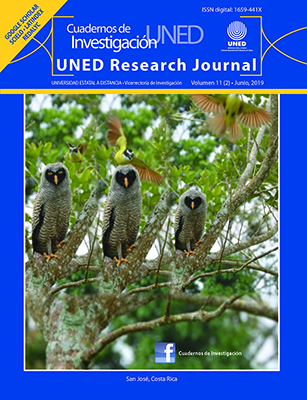Avifauna composition and richness in four vegetation types, San Ramón, Costa Rica
DOI:
https://doi.org/10.22458/urj.v11i2.2177Keywords:
habitats, riparian forest, live fences, abundance, richnessAbstract
Introduction: wild birds are important for humans as biological control and seed dispersers, among others. In turn, they can be affected by changes in landscape structure. Objective: to analyze the composition and richness of avifauna in four vegetation types of San Ramón, Costa Rica, between May and August 2016. Methods: point sampling with a fixed 25m radius (75m between points, 10min per observation) produced 548 individuals from 27 families and 75 species. Results: the most abundant species were Ramphocelus passerinii, Turdus grayi, Crotophaga sulcirostris and Troglodytes aedon. Species richness and abundance were higher in pasture with high canopy cover, and in riverine forest, than in live fences and pastures with low canopy cover. Habitats with the most similarity were riverine forest and live fences. Additionally, 39% of the represented species were insectivorous, 23% frugivorous, 17% omnivorous, 16% carnivorous, 4% seed eaters, and 1% was nectar eater. Lastly, five species were “Forest Dependent” and six were “Indicative of Forest”. Conclusion: finally, it should be noted that the areas with the highest vegetation coverage, food availability and refuge areas were the ones with the highest number of species and the most similar sites are determined by the connectivity between them.
References
Areskoug, V. (2001). Utilization of remnant dry-forest corridors by the native fauna in a pastoral landscape in the Paraguayan Chaco. Centrum för Biologisk Mångfald, 3, 25-38.
Carvajal, J. P. (2008). Ensamble de aves, murciélagos y escarabajos estercoleros en diferentes tipos de cobertura vegetal en un agropaisaje del norte de Costa Rica (Tesis de maestría). Universidad Nacional, Heredia, Costa Rica.
Cárdenas, G., Harvey, C., Ibrahim, M., & Finegan, B. (2003). Diversidad y riqueza de aves en diferentes hábitats en un paisaje fragmentado en Cañas, Costa Rica. Agroforestería en las Américas, 10, 78-85.
del Hoyo, J., Elliott, A., & Sargatal, J. (1994). Handbook of the Birds of the World. Barcelona, España: Lynx Ediciones.
Dufrene, M., & Legendre, P. (1997). Species assemblages and indicator species: the need for a flexible asymmetrical approach. Ecological Monographs, 67, 345-366. DOI: 10.2307/2963459
Elizondo, L. (2013). crbio.cr. Recuperado de http://www.crbio.cr:8080/neoportlweb/species/Gampsonyx%20swainsonii
Estrada, A., Coates, R., & Meritt, D. (1997). Anthropogenic landscape changes and avian diversity at Los Tuxtlas, Mexico. Biodiversity and Conservation, 6, 19-43. DOI: 10.1023/A:1018328930981
Haber, W. (1999). Remnant trees and the conservation of biodiversity in Costa Rican pastures. Agroforestry Systems, 44, 37-68.
Harvey, C., Alpízar, F., Chacón, M., & Madrigal, R. (2005). Assessing Linkages between Agriculture and Biodiversity in Central America: Historical Overview and Future Perspectives. San José, Costa Rica: The Nature Conservancy Mesoamerican & Caribbean Region, Conservation Science Program.
Holdridge, L. (1987). Ecología basada en zonas de vida. San José, Costa Rica: IICA
INEC. (2015). VI Censo Nacional Agropecuario. Recuperado de http://www.inec.go.cr/sites/default/files/documentos/agropecuario/publicaciones/reagropeccenagro2014-ti-006.pdf
Kattan, G.H. (2002). Fragmentación: patrones y mecanismos de extinción de especies. Cartago, Costa Rica: Libro Universitario Regional.
MARENA. (1999). Sistema de vedas de especies silvestres nicaragüense que regirá en el año 2000 (Resolución ministerial No. 023.99). Managua, Nicaragua: Ministerio del Ambiente y los Recursos Naturales.
Pérez, A.M., Sotelo, M., Ramírez, F., Ramírez, I., López, A., & Siria, I. (2006). Conservación de la biodiversidad en sistemas silvopastoriles de Matiguás y Rio Blanco (Matagalpa, Nicaragua). Ecosistemas, 3, 125-141.
Ralph, C.J., Geupel, G., Pyle, P., Martin, T., DeSante, D., & Milá, B. (1996). Manual de métodos de campo para el monitoreo de aves terrestres. Albany, CA: Pacific Southwest Research Station, Forest Service, U.S. Department of Agriculture.
Sánchez, A. (2009). Ensamble y ocurrencia de aves en bosques sometidos a manejo forestal, Región Huetar Norte, Costa Rica (Tesis de maestría). Universidad Nacional, Heredia, Costa Rica.
Schulze, C.H., Waltert, M., Kessler, P.J., Pitopang, R., Shahabuddin., Veddeler, D., … Tscharntke, I. (2004). Biodiversity Indicador Group of Tropical Land-Use Systems: Comparing Plants, Birds, and Insects. Ecological Applications, 14, 1321-1333. DOI: 10.1890/02-5409
Stiles, F. G. (1985). Conservation of forest birds in Costa Rica: Problems and perspectives. ICBP Technical Publication, 4, 141-168.
Stiles, FG., & Skutch, A. (1998). Guía de Aves de Costa Rica. Heredia, Costa Rica: Editorial INBio.
Vílchez, S., Harvey, C., Sánchez, D., Medina, D., & Hernández, B. (2004). Diversidad de aves en un paisaje fragmentado. Encuentro, 68, 60-75.
Waltert, M., Mardiastuti, A., & Muhlenberg, M. (2004). Effects of land use on birds species richness in Sulawesi, Indonesia. Conservation Biology, 18, 1339-1346. DOI: 10.1111/j.1523-1739.2004.00127.x
Published
How to Cite
Issue
Section
License
Note: This abstract contains an incorrect copyright due to technical issues. Authors who publish with this journal agree to the following terms: Authors retain copyright and grant the journal right of first publication with the work simultaneously licensed under a Creative Commons Attribution License that allows others to share the work with an acknowledgement of the work's authorship and initial publication in this journal
All journal contents are freely available through a CC BY 4.0 license.
CC BY 4.0 is a Creative Commons: you can copy, modify, distribute, and perform, even for commercial reasons, without asking permission, if you give appropriate credit.
Contents can be reproduced if the source and copyright are acknowledged according to the Open Access license CC BY 4.0. Self-storage in preprint servers and repositories is allowed for all versions. We encourage authors to publish raw data and data logs in public repositories and to include the links with all drafts so that reviewers and readers can consult them at any time.
The journal is financed by public funds via Universidad Estatal a Distancia and editorial independence and ethical compliance are guaranteed by the Board of Editors, UNED. We do not publish paid ads or receive funds from companies.
